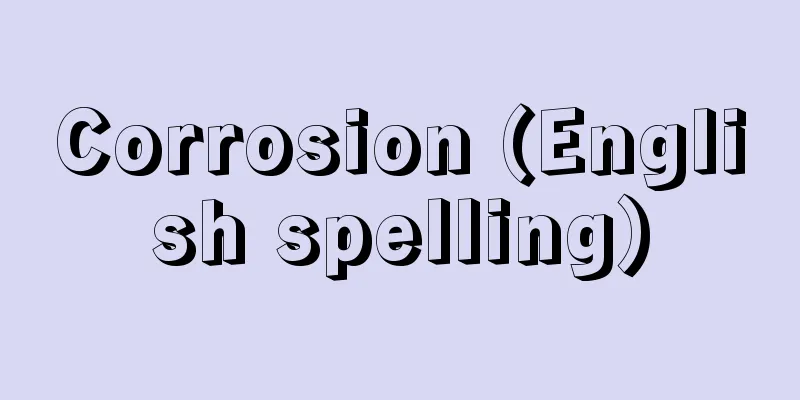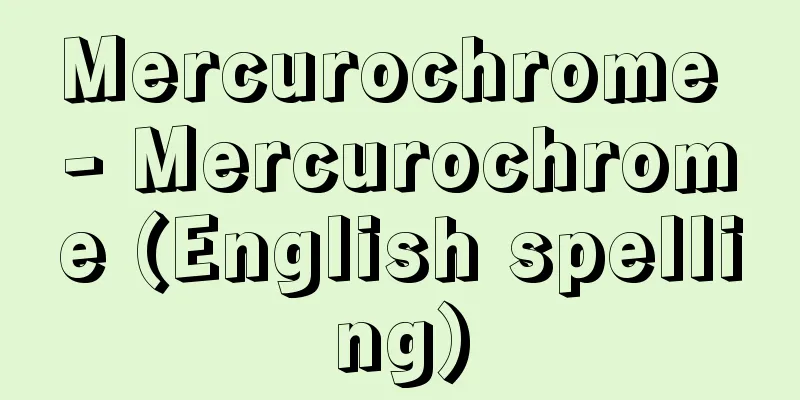Corrosion (English spelling)

|
A phenomenon in which metallic materials react with substances in the environment in which they are used, turning into metallic ions or non-metallic compounds and becoming worn away. Various forms of corrosion appear depending on the combination of the type of metallic material and the environment in which it is used, but they are broadly divided into wet corrosion and dry corrosion, depending on whether the environment is an aqueous solution or gas. Furthermore, some corrosion phenomena only appear when the material is under stress, so these are further subdivided according to whether they are corrosion under stress or not. Corrosion of machines and equipment is often the cause of accidents, so it is important to take sufficient precautions against corrosion on a daily basis. Next, we will discuss the main forms of corrosion and their causes. [Katsuhisa Sugimoto] General corrosionA type of corrosion in which the metal is uniformly reduced in its thickness direction. It occurs in highly corrosive environments where a film of corrosion products does not form on the metal surface. Examples of this type of corrosion include the corrosion of iron and aluminum in acid. [Katsuhisa Sugimoto] Intergranular corrosionThis type of corrosion occurs when only the grain boundaries of a metal are selectively dissolved. It occurs when precipitates or solute-depleted zones with easily soluble compositions are formed at or near the grain boundaries through heat treatment, etc. This type of corrosion can be seen, for example, when 18-8 stainless steel that has been heated to 500-800°C for a short time is immersed in a sulfuric acid-copper sulfate solution. [Katsuhisa Sugimoto] Pitting CorrosionAlthough most of the surface is intact, small, deep pin-point-like holes may occur in only a small area. This type of corrosion is likely to occur when the surface film is locally destroyed by chloride ions in the environment, and is commonly seen on stainless steel and aluminum immersed in seawater. [Katsuhisa Sugimoto] Crevice corrosionCorrosion occurs in narrow gaps that form between metal joints, under foreign matter attached to the surface of a metal, etc. Because the supply of dissolved oxygen inside the gap is insufficient compared to the outside, the metal inside the gap is less likely to become passivated, and so the metal in this area continues to actively dissolve, resulting in corrosion. [Katsuhisa Sugimoto] Stress Corrosion CrackingWhen a weak tensile stress that would never cause mechanical destruction in a non-corrosive environment acts on a metal material used in a corrosive environment, the material suddenly breaks down after a certain period of time. It is said to occur when part of the surface film is destroyed by mechanical stress, concentrating corrosion there. It is known to occur in 18-8 stainless steel in chloride solutions, brass in ammonia gas, and carbon steel in caustic alkali solutions. [Katsuhisa Sugimoto] Hydrogen embrittlementThis phenomenon occurs when hydrogen produced during corrosion is absorbed into a metal material, making the metal brittle and causing it to break even under low tensile stress. This phenomenon is seen in high-tensile steel in sulfide solutions. [Katsuhisa Sugimoto] Corrosion fatigueThis occurs in metal materials that are subjected to alternating tensile and compressive stresses in a corrosive environment. Even under small stresses that would not cause fatigue failure in a non-corrosive environment, fatigue failure occurs in a relatively short time in a corrosive environment. [Katsuhisa Sugimoto] Erosion and corrosionA type of corrosion in which the film on a metal surface is stripped away by the continuous collision of fluid or powder particles, causing active dissolution of the metal surface and deep localized erosion. It is often seen in piping and pumps used for transporting slurry. [Katsuhisa Sugimoto] [Reference] |Source: Shogakukan Encyclopedia Nipponica About Encyclopedia Nipponica Information | Legend |
|
金属材料が使用環境中の物質と反応して金属イオンまたは非金属の化合物となって損耗していく現象。金属材料の種類と使用環境との組合せに応じてさまざまな形態の腐食が現れるが、使用環境が水溶液であるかガスであるかによって湿食と乾食とに大きく分けられている。さらに腐食現象のなかには、材料に応力が作用している状態でのみ現れるものもあるので、応力下での腐食であるか否かによってこれらは細分化されている。機械や装置の腐食は事故の原因となることが多いので、防食対策には日ごろから十分の配慮が必要である。次に、おもな腐食形態とその原因について述べる。 [杉本克久] 全面腐食金属が厚さ方向に均一に減少していく型の腐食。金属の表面に腐食生成物の皮膜が形成されないような強い腐食性の環境中で生じ、酸の中での鉄やアルミニウムの腐食がこれに相当する。 [杉本克久] 粒界腐食金属の粒界のみが選択的に溶解される型の腐食。熱処理などにより粒界およびその近傍に溶解されやすい組成の析出物や溶質欠乏帯が形成されたときに生ずる。そして、これは500~800℃に短時間加熱された18-8ステンレス鋼を硫酸‐硫酸銅溶液につけたときなどにみられる。 [杉本克久] 孔食表面の大部分は健全であるにもかかわらず、ごく一部にのみ針で突いたような小さくて深い孔状の腐食がおこることがある。この型の腐食は、環境中の塩素イオンにより表面皮膜が局部的に破壊されるときに生じやすく、海水中につけられたステンレス鋼やアルミニウムによくみられる。 [杉本克久] すきま腐食金属どうしの継ぎ目や金属の表面に付着した異物の下などにできた狭いすきまに生じる腐食。すきま内部は外部に比べて溶存酸素の供給が不十分であるため、すきま内部の金属は不動態化しにくく、そのためこの部分の金属が活性溶解を続けることによって生ずる。 [杉本克久] 応力腐食割れ腐食性でない環境中ではけっして機械的破壊を生じないような弱い引張り応力が腐食性環境中で使用されている金属材料に作用したとき、ある期間経過後に突然その材料の破壊が生ずる型の腐食。機械的応力により表面皮膜の一部が破壊され、そこに腐食が集中することにより生ずるといわれている。塩化物水溶液中の18-8ステンレス鋼、アンモニアガス中の黄銅、カ性アルカリ水溶液中の炭素鋼などに生ずることが知られている。 [杉本克久] 水素脆性腐食時に生じた水素が金属材料中に吸収され、それによって金属材料が脆(ぜい)化し、弱い引張り応力の下でも破壊してしまう現象である。硫化物水溶液中における高張力鋼などにみられる。 [杉本克久] 腐食疲労腐食性環境中で引張り―圧縮の交番応力が作用している金属材料に生ずる。腐食性でない環境中では疲労破壊が生じないような小さな応力の下でも、腐食性環境中では比較的短時間で疲労破壊が生ずる。 [杉本克久] エロージョン・コロージョンerosion corrosion流体または粉体粒子の連続的な衝突により金属表面の皮膜がはぎ取られ、その部分が活性溶解をおこして局部的に深く侵食される型の腐食。スラリー輸送の配管やポンプなどによくみられる。 [杉本克久] [参照項目] |出典 小学館 日本大百科全書(ニッポニカ)日本大百科全書(ニッポニカ)について 情報 | 凡例 |
Recommend
Interest coverage - intaresutokabarage (English spelling) interest coverage
An index that shows the weight of a company's ...
Fish scales illustrated book
A land register from the Ming and Qing dynasties ...
Daudet, Alphonse
Born: May 13, 1840. Gall, Nimes [Died] December 16...
Georges Dumézil
French linguist and mythologist. He was also a me...
Anemone nigricans - Anemone nigricans
...A perennial plant of the Ranunculaceae family ...
Education Reform Committee
This investigative council was established under t...
Thiobacillus
…Bacteria that oxidize sulfur or inorganic sulfur...
Murner, Thomas
Born: 24 December 1475 in Oberenheim Died: August ...
Apuseni Mountains - Apusenisanchi
…A mountain range that is part of the Alpine-Hima...
Old English (English spelling) OldEnglish
…another name for Old English (OE). It is a diale...
Ludic
...The dialects are divided into the northern dia...
Blue Damselfly - Blue Damselfly
…The yellow dragonfly Ceriagrion melanurum (illus...
Orientales (English spelling)
...In literature, early examples include Galland&...
Genna surname anthology - Genna surname anthology
A clan book compiled by Prime Minister Li Jifu an...
Shikoku 88 Temples - Shikoku Hachiju Hakkashyo
Shikoku Pilgrimage, also known as the 88 Temples o...
![Tomizawa [town] - Tomizawa](/upload/images/67cc5b06c8a4d.webp)








